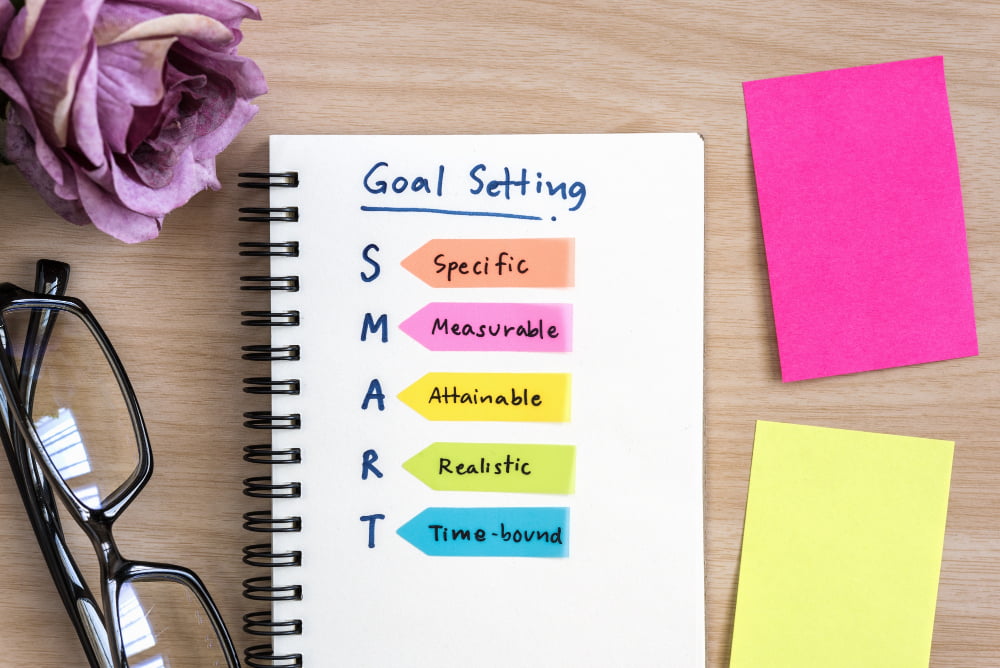Learn practical tips to organize your calendar and schedule effectively so that you can achieve your goals and maximize your time.
As a busy mom of three, I used to feel like my life was a never-ending cycle of chaos. Between work, school pickups and drop-offs, extracurricular activities, and household chores, it seemed like there just weren’t enough hours in the day to get everything done.
I felt like I was constantly playing catch-up and falling behind on my goals. But then I discovered the power of organizing my calendar and schedule.
By taking control of my time and prioritizing what really mattered to me, I was able to achieve more than ever before. In this blog post, I’ll share with you some strategies for organizing your own calendar and schedule so that you can maximize your time and achieve your goals too!
Setting SMART Goals

One of the keys to organizing your calendar and schedule is setting SMART goals. SMART stands for Specific, Measurable, Achievable, Relevant, and Time-bound.
When you set a goal that meets these criteria, you’re more likely to achieve it because it’s clear what you need to do and when.
For me personally as a blogger who writes about decluttering and organizing my home office space was one of my biggest priorities this year. I knew that in order to achieve this goal I needed specific actions like clearing out old files from my computer or getting rid of unnecessary paperwork on my desk.
By breaking down the larger goal into smaller tasks with deadlines attached (like “clear out computer files by end of week” or “tackle desk clutter by Friday”), I was able to make steady progress towards achieving it without feeling overwhelmed.
Setting SMART goals has been a game-changer for me in terms of maximizing my time and achieving what matters most. By taking control over how I spend each day through effective scheduling techniques like prioritizing tasks based on their importance level while keeping an eye on deadlines; anyone can accomplish their own personal objectives too!
Prioritizing Tasks

One of the most important steps in organizing your calendar and schedule is prioritizing tasks. As a busy mom, I quickly realized that not all tasks are created equal.
Some things simply have to be done, like picking up my kids from school or going grocery shopping. But other things can wait or even be delegated to someone else.
To prioritize effectively, start by identifying your goals and what’s most important to you. For me, spending quality time with my family was at the top of my list.
So I made sure that any work-related tasks were scheduled around our family time rather than the other way around.
Next, make a list of all the tasks you need to accomplish each day or week and rank them in order of importance based on how they align with your goals and values.
By prioritizing effectively, you’ll find yourself accomplishing more meaningful work while still having plenty of time for relaxation and fun activities with loved ones – just like I did!
Time Blocking Techniques

Time blocking involves breaking your day into chunks of time, each dedicated to a specific task or activity.
By doing this, you can ensure that you’re making progress on all your priorities without getting sidetracked by distractions.
For example, I used to find myself constantly checking my email throughout the day and losing focus on other tasks as a result. But with time blocking, I set aside specific times during the day to check and respond to emails so that it didn’t interfere with other important work.
Time blocking also helps me stay accountable for how much time I’m spending on certain activities. It’s easy to lose track of how long we spend scrolling through social media or chatting with coworkers if we don’t have a clear plan in place.
By using this technique consistently over several weeks, it became easier for me not only manage my daily tasks but also achieve bigger goals like writing more blog posts or starting an exercise routine.
If you’re feeling overwhelmed by your schedule and struggling to make progress towards achieving your goals – give time-blocking a try! With some practice and consistency in implementing this technique into our lives will help us maximize our productivity while still having enough free-time left over at the end of each day!
Digital Vs. Paper Calendars

When I first started organizing my schedule, I was torn between using a digital calendar or sticking with the traditional paper planner. On one hand, digital calendars are convenient and accessible from anywhere.
But on the other hand, there’s something satisfying about physically crossing off tasks on a to-do list.
After some trial and error, I found that what worked best for me was a combination of both. My Google Calendar keeps track of all my appointments and deadlines while my bullet journal serves as an extension of my brain where I can jot down notes and ideas.
The key is finding what works best for you – whether it’s solely relying on your phone or tablet to keep track of everything or going old-school with pen-and-paper planning.
No matter which method you choose though, remember that organizing your calendar isn’t just about scheduling appointments; it’s also about making time for yourself so that you can achieve your goals without feeling overwhelmed by life’s demands. By taking control of your time in this way, you’ll be amazed at how much more productive (and less stressed) you feel!
Color-Coding Your Schedule

When I first started using this method, it felt a bit overwhelming. But once I got the hang of it, my life became so much easier! By assigning different colors to various activities on my calendar, I was able to quickly see what needed my attention each day.
For example, all work-related tasks were assigned a blue color while family events were marked in green. This made it easy for me to glance at my schedule and know exactly what was coming up next without having to read through every single item on the list.
Color-coding also helped me prioritize better since urgent tasks could be highlighted in red while less important ones could be assigned lighter shades like yellow or orange.
By taking control of your time with simple techniques like color-coding your schedule you can achieve more than ever before!
Allocating Breaks and Downtime

As a busy mom, I used to feel guilty taking time for myself because there was always something else that needed to be done.
But what I realized is that by not taking breaks, my productivity suffered, and I ended up feeling burnt out.
Nowadays, when planning my schedule for the week ahead, I make sure to allocate some time each day for self-care activities like exercise or reading a book. This helps me recharge my batteries so that when it’s time to tackle work tasks or household chores again, I’m refreshed and ready to go.
It’s also essential not just to allocate downtime but also stick with it! It can be tempting sometimes just “to finish one more thing” before taking a break but remember: you deserve this break! By sticking with your allocated downtime consistently over time will help you become more productive in the long run while avoiding burnout.
Allocating breaks may seem counterintuitive at first glance; however – as someone who has experienced firsthand how much difference they can make – trust me on this one: take those well-deserved breaks!
Weekly and Monthly Reviews

During these reviews, you’ll take a step back from the day-to-day chaos to evaluate how you’re spending your time and make adjustments as needed.
For me, conducting weekly reviews has been a game-changer. Every Sunday evening, I sit down with my planner and review what’s coming up in the week ahead.
I block out time for work projects, appointments, school events – anything that requires my attention during that week. This helps me get a clear picture of what’s on my plate so that I can plan accordingly.
Monthly reviews are also crucial because they allow you to zoom out even further and evaluate how well you’re progressing towards your long-term goals. During this review process, take some time to reflect on what worked well during the past month (and do more of it!) as well as areas where improvement is needed (and adjust accordingly).
By taking just an hour or two each week/month for these types of evaluations/reviews will help ensure that everything stays organized while maximizing productivity!
Related Stories
- Organizing for Productivity: Boost Efficiency in a Streamlined Workspace
- Digital Organization Strategies: Streamline Your Digital Life for Greater Efficiency
- Maintaining Organization Habits: How to Keep Your Home Tidy for the Long Term
- Time-Saving Organization Hacks: Quick and Effective Ways to Keep Your Home Tidy
- Organizing Your Workspace: Boost Productivity With a Clean and Organized Office